Displaying items by tag: 2022
Agriculture Questions and Answers - Grade 5 End of Term 1 Exams 2022 SET 1
QUESTIONS
- Grade 5 pupils were investigating on the best soil for modelling. Which answer did they give?
- When making compost manure which activity helps in quick rotting of the compost heap? (Adding ash, Adding kitchen waste, Sprinkling water)
- Which of the animals below can be classified as harmful
- Mongoose
- Dog
- Goat
- The soil which holds very little water is
- Write True or False
Cotton grows very well in loam soil. - Draw a watering can for practicing drip irrigation.
- Which of the following is NOT a use of water in the farm
- Mixing farm chemicals
- Watering animals
- Watering plants
- Explain the use of a scare crow in a farm
- Write 3 materials that can be used to make a scare crow (3mks)
- Write down 2 ways of soil recovery
- ........................... is the carrying away of top fertile soil by water or wind.
- A ................. bed is a small raised area of land prepared to sow seeds.
- Write down two types of waste which should not be put in a waste pit.
- What is the importance of mulching?
- Removing the weak or thin seedlings to allow space for healthy growing seedlings is called (irrigation, transplanting, thinning)
- Draw the tool used by a farmer for transplanting
- What is the colour of unripe tomatoes?.
- Write down two leguminous crops
- Manure adds ................... to the soil.
- Which animal gives us milk and mutton?
ANSWERS
- clay soil
- Adding kitchen waste
- Mongoose
- sandy soil
- True
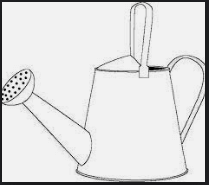
- Mixing farm chemicals
- to deter birds or other animals from eating or otherwise disturbing seeds, shoots, and fruit; its name derives from its use against the crow.
- Grass clippings, hay, wood chips, leaves and rags
- use of green manure (uprooted or sown crop parts incorporated or left on topsoil), cover crops, crop rotation and organic compost.
- soil erosion
- seed
- old batteries, pesticides, paint, and car oil
- Mulches conserve the soil moisture, enhance the nutrients status of soil, control the erosion losses, suppress the weeds in crop plants, and remove the residual effects of pesticides, fertilizers, and heavy metals. Mulches improve the aesthetic value of landscapes and economic value of crops.
- thinning

- green
- beans, soybeans, peas, chickpeas, peanuts, lentils, lupins, mesquite, carob, tamarind, alfalfa, and clover.
- nutrients / organic matter
- sheep
Religious Studies CRE & IRE Questions and Answers - Grade 5 End of Term 1 Exams 2022 SET 1
QUESTIONS
CHRISTIAN RELIGIOUS EDUCATION
- List the responsibilities God has given us over his creation.(1 mk)
- When God created Adam and Eve, He gave man the power to rule over animals. This means that taking care of animals is our ...............(responsibility, talent)(1 mk)
- The sentences below explain what happens to children who experience child labor. Choose an answer from the box below for each sentence.
Body injuries absenteeism tiredness Poor health - Elizabeth misses school at least three times a week....................... (1 mk)
- One of Ezra's eyes is swollen. Some chemicals got into his eye while he was working in the flour factory..............(1 mk)
- Malkia is very thin and weak.............................(1 mk)
- David is always sleepy during lessons.................... (1 mk)
- Rearrange the jumbled letters to get the correct words.
- SAENK (1 mk)
- VEE (1 mk)
- MADA (1 mk)
- DOYSIEB (1 mk)
- How did Adam and eve disobey God? (1 mk)
- Explain the importance of obeying school rules. (1 mk)
- What is family unity? (1 mk)
- Write down the values that promote unity in a family. (3mk)
- What challenges does a family face? (2mk)
- Why is the bible referred to as a guide? (1 mk)
- How does the bible help you relate well with your teachers? (1 mk)
- The word puzzle below has some hidden values that we can acquire through reading the bible. Find the values. (4mk)
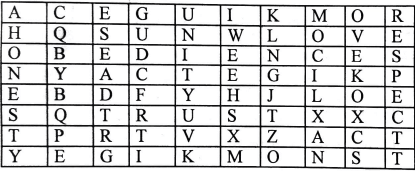
- Who arrested Peter and John? (1 mk)
- Write what you will do to show courage in the following situations:
- Your friend asks you to smoke cigarettes. (1mk)
- Your friend is asking you to watch an ungodly movie. (1mk)
ISLAMIC RELIGIOUS EDUCATION
- Which sura describe the events of the year the elephant.
- "Veryil he who hates you O Mohammad will be cut off from all that is good". Which of the verses below matches this questions.
- Faswal-lilirab-rabika wanbar. '
- In-nal aatwaynakal kaothar'
- Falyaboduu rab-ba haadhalbayi
- In-na shani-aka-huwal abtar.
- The virtues is taught in Suratul Asr.
- The story of the elephant is taught in which Surah?
- Complete the verse from surah Takathur
Nata zur tumol.................... - Worship Allah as if you see him for if you do not see him he sees you. This is a pillar of ......................................
- The best gift to our parents?
- Complete the following hadith
"Paradise is under the feet of our ............................" - When visiting someone's house we should knock .............................. times.
- Write the four sources of fiqh.
- In Islamic sheriah things that annoy others but are not sin are called .....................
- The mother of Nabii Issa was called ...................................
- Blood is an example of .................................. najis
- ................................is the book that was given to prophet Daud.
- ...............................will blow the trumpet on the day of judgement.
MARKING SCHEME
CHRISTIAN RELIGIOUS EDUCATION
- List the responsibilities God has given us over his creation.(1 mk)exercising both dominion and stewardship over the earth
- When God created Adam and Eve, He gave man the power to rule over animals. This means that taking care of animals is our ...............(responsibility, talent)(1 mk)
- The sentences below explain what happens to children who experience child labor. Choose an answer from the box below for each sentence.
Body injuries absenteeism tiredness Poor health - Elizabeth misses school at least three times a week.........absenteeism .............. (1 mk)
- One of Ezra's eyes is swollen. Some chemicals got into his eye while he was working in the flour factory.....Body injuries.........(1 mk)
- Malkia is very thin and weak........Poor health .....................(1 mk)
- David is always sleepy during lessons.........tiredness........... (1 mk)
- Rearrange the jumbled letters to get the correct words.
- SAENK (1 mk) SNAKE
- VEE (1 mk) EVE
- MADA (1 mk) ADAM
- DOYSIEB (1 mk) DISOBEY
- How did Adam and eve disobey God? (1 mk)
THEY ATE THE FORBIDDEN FRUIT - Explain the importance of obeying school rules. (1 mk)
In addition to self-preservation, obedience to school policies and procedures shows that you respect your peers and consider their personal safety to be of the utmost importance. Obedience also demonstrates you believe the education of your peers is vital to their future well-being. - What is family unity? (1 mk)
maintaining the family group without deviation or change. - Write down the values that promote unity in a family. (3mk)
Build a circle of trust.
Find your family purpose. Create a family vision together so that each member becomes an active, willing participant at the outset.
Be your own guru
Check in with everyone.
Rotate leadership.
Share your stories.
Lead with vulnerability.
Communicate, Communicate, Communicate. ...
Establish a family culture. ...
Compassion & Compromise. ...
Consistency is key. ...
Have fun together. - What challenges does a family face? (2mk)
Different personalities clashing and disagreements over ways of doing things.
Jealousy or fighting between brothers and sisters.
Parents arguing.
Divorce or separation.
New step-parents or step-brothers and sisters.
A parent or relative having mental health problems, disabilities or illness. - Why is the bible referred to as a guide? (1 mk)
The Bible is used by Christians to give them guidance about how they can live their their lives in the way God would want them to. - How does the bible help you relate well with your teachers? (1 mk)
By offering guidance - The word puzzle below has some hidden values that we can acquire through reading the bible. Find the values. (4mk)
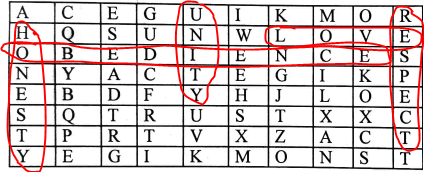
- Who arrested Peter and John? (1 mk)
the temple police - Write what you will do to show courage in the following situations:
- Your friend asks you to smoke cigarettes. (1mk)
say no - Your friend is asking you to watch an ungodly movie. (1mk)
say no and leave
- Your friend asks you to smoke cigarettes. (1mk)
ISLAMIC RELIGIOUS EDUCATION
- Which surah describe the events of the year the elephant.
Surah 105, Al-Fil (Arabic: الـفِـيـل, "The Elephant"), and is discussed in its related tafsir. - "Verily, he that hates thee has indeed been cut off [from all that is good". Which of the verses below matches this questions.
- Faswal-lilirab-rabika wanbar. '
- In-nal aatwaynakal kaothar'
- Falyaboduu rab-ba haadhalbayi
- In-na shani-aka-huwal abtar.
- The virtues is taught in Suratul Asr.
- The story of the elephant is taught in which Surah?
- Complete the verse from surah Takathur
Nata zur tumol.................... - Worship Allah as if you see him for if you do not see him he sees you. This is a pillar of ......................................
- The best gift to our parents?
- Complete the following hadith
"Paradise is under the feet of our ............................" - When visiting someone's house we should knock .............................. times.
- Write the four sources of fiqh.
- In Islamic sheriah things that annoy others but are not sin are called .....................
- The mother of Nabii Issa was called ...................................
- Blood is an example of .................................. najis
- ................................is the book that was given to prophet Daud.
- ...............................will blow the trumpet on the day of judgement.
Environment & Religious Activities Questions and Answers - Grade 5 End of Term 1 Exams 2022 SET 1
QUESTIONS
Social Studies
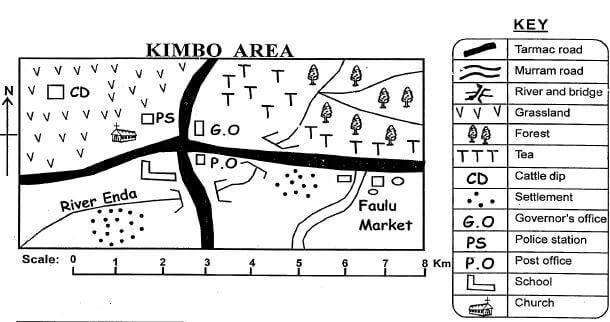
Use the map of Kimbo Area to answer questions 1 - 4.
- What is the climate of the North Eastern region of Kimbo Area? (1 mark)
- Who is the head of Kimbo Area? (1 mark)
- What is the religion of the people in Kimbo Area? (1 mark)
- River Enda flows towards which direction? (1 mark)
- List any 2 elements for a map. (2 marks)
- A compass has how many cardinal points? (1 mark)
Use the map of Kenya below to answer questions 7 - 10:
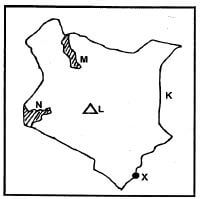
- The country that boarders Kenya marked K is (1 mark)
- The lake marked M is called (1 mark)
- The mountain marked L is known as (1 mark)
- The lake marked N is known as (1 mark)
- What is weather? (1 mark)
- What is climate? (1 mark)
- List any 4 historic built environments in Kenya. (4 marks)
- List any 3 methods of instruction used in traditional education in promoting values. (3 marks)
- List any 2 administrative leaders in a school.(2 marks)
- Outline any 4 duties of administrative leaders in school. (4 marks)
- List 4 language groups in Kenya. (4 marks)
Assessment Rubrics - Social Studies
| Level | 4 | 3 | 2 | 1 |
| Score | 28-30 | 19-27 | 10-18 | 0-9 |
C.R.E
- Outline 3 lessons that we can learn from the parable of the talents. (3 marks)
- Identify any 3 responsibilities given to human beings by God. (3 marks)
- Give 4 causes of child labour. (4 marks)
- Give 4 lessons learnt from the fall of human beings in the garden of Eden. (4 marks)
- List the 3 members of a nuclear family. (3 marks)
- State 2 uses of the Bible. (2 marks)
- List down the first 5 books of the New Testament of the Bible. (5 marks)
- Give two good qualities learnt from the story of Peter and John at the temple. (2 marks)
- Name the three sons of Noah. (3 marks)
- Prophet Elijah held a contest with the false prophets of Baal at Mount (1 mark)
Assessment Rubrics - CRE
| Level | 4 | 3 | 2 | 1 |
| Score | 28-30 | 19-27 | 10-18 | 0-9 |
MARKING SCHEME
SOCIAL STUDIES
- Cool and wet
- Governor
- Christianity
- South West
- Frame, title, key, compass
- 4
- Somalia
- Turkana
- Kenya
- Victoria
- Daily changes in the atmosphere
- Average changes in the atmosphere over a long period of time
- Museum, monuments
- Proverbs, stories, riddles
- Headteacher, prefect, deputy headteacher
- -Ensuring the school is clean
-Ensuring the school is safe
-Ensuring learners are following set rules
-Punishing learners who break laws - Nilotes, Cushites, Bantus, Semites
C.R.E
- -We should use our abilities well
-We should be honest
-We should be hardworking - -Taking care of God's creation
-Giving birth
-oberying God's commandments - -Poverty
-Lack of parental care
- Death of parents
- Peer influence - -We should be obedient
- We should follow God's commands
- We should tell the truth always
-Sin separates us from God - Mother, father, children
- -Reading to learn God's word
- Reading in school when learning C.R.E - Matthew, Mark, Luke, John, Acts
- Faith, courage
- Shem, Ham, Japheth
- Carmel
Monitoring Learners' Progress - Grade 5 Competence Based Assessment Term 1 2022 Social Studies Activities
QUESTIONS
- Draw and Name four cardinal points of a compass (4marks)
- Name five main elements of a map (5 marks)
- Name two example of a museum in Kenya ( 2marks)
- Why is a museum important to people (1 marks)
- Give 3 examples of Proverbs from your community (3 marks)
- Give two examples of Riddles from your community (2 marks)
- Who are the three leaders in a school administration (3 marks)
- 2 Examples of skills that were put on the African way of education (2 marks)
- What are the two duties of a deputy head teacher in a school (2marks)
- Give five examples of relief features (5 marks)
- Draw and design a method of instruction used in African traditional education (4 marks)
- What are the two things you should do to support leaders in your school (2marks)
- What are the three importance of prefects in a school (3marks)
- Give three examples of Valleys in Kenya (3 marks)
- What is a monument (2marks)
- What are the 5 examples of language groups in Kenya (5 marks)
- Name two mountains found in Kenya (2marks)
- Name two plains found in Kenya (2marks)
- What is weather ___________________________________________(2marks)
- Answer the following questions according to the instructions given (3marks)
- What is the size of Kenya in square kilometers ________________________
- How many countries share a border with Kenya __________________
- What is the name of your county_______________________________________
- Give three examples of the neighbors of your County (3marks)
| Exceeding Expectation | Meeting Expectation | Approaching Expectation | Below Expectation |
| 50 - 60 | 40 - 49 | 20 - 39 | 0 - 19 |
Kiswahili Questions and Answers - Grade 5 End of Term 1 Exams 2022 SET 1
MASWALI
SEHEMU 1: KUSIKILIZA NA KUZUNGUMZA
Mwalimu amsomee mwanafunzi kifungu hiki kisha amwulize maswali yafuatayo.
Paka yuko jikoni. Amebeba panya mdomoni. Panya huyo ni mweusi. Paka anajificha mvunguni mwa meza. Mama anamwona paka.
- Paka yuko wapi?
(Mwanafunzi ajibu) - Paka amebeba nini mdomoni?
(Mwanafunzi ajibu) - Panya huyo ni wa rangi gani?
(Mwanafunzi ajibu) - Paka anajificha wapi?
(Mwanafunzi ajibu) - Nani anamwona paka?
(Mwanafunzi ajibu)
Vigezo vya Kutathminia Kusikiliza na kuzungumza
| Kiwango cha utendaji | 4 | 3 | 2 | 1 |
| Upeo/Alama | 5 | 4 | 3 | 0 - 2 |
SEHEMU 2: KUSOMA KWA SAUTI (Alama 5)
Mwanafunzi asome kifungu hiki kwa sauti.
Ilikuwa siku ya Ijumaa tulipokuwa sebuleni tukitazama runinga. Sabu alianza kutusimulia jinsi ambavyo mwalimu wao alikuwa akiwaeleza kuhusu umuhimu wa miti. Hata ingawa alikuwa shuleni miaka sitini iliyopita, alikuwa akiyakumbuka vizuri.
Alianza kwa kusema kuwa mwalimu wao alisema kuwa miti huwa ni maskani ya wanyama mbalimbali sanasana nyuni ambao hutengeneza viota vyao na kutagia mayai humo. Aliendelea kutuambia kuwa wanyama wengine wanaotegemea miti kama makazi ni wanyamapori kama vile simba, chui, pundamilia na wengine.
Vigezo vya Kuathminia - Kusoma
| Kiwango cha utendaji | 4 | 3 | 2 | 1 |
| Maneno yaliyosomwa katika dakika moja | 60 na zaidi | 41 - 60 | 21 - 40 | 0-20 |
SEHEMU 3: UFAHAMU (Alama 5).
Mwanafunzi asome kifungu hiki na kujibu maswali.
- NDOTO YA AMINA
Babu alimnunulia Amina godoro na foronya. Usiku alipolala aliota ndoto. Aliota kuwa alikuwa msichana mkubwa. Alikuwa akifanya kazi ya ualimu. Baada ya miaka miwili aliacha ualimu akawa mkulima. Aliuza mazao akapata shilingi laki tatu. Alipokuwa akipeleka pesa zake benkini, aliamka kutoka usingizini.- Nani alimnunulia Amina godoro?
- Aliota ndoto wakati gani?
- Mara ya kwanza alikuwa akifanya kazi gani?
- Baada ya miaka miwili alianza kufanya kazi gani?
- Alikuwa akipeleka pesa zake wapi?
- MWALIMU BIDII
Mwalimu Bidii ni mwalimu wa Kiswahili. Anafundisha katika shule ya msingi ya Hekima. Kila siku yeye hutukumbusha kuwa tuwe watoto safi. Kuna siku alituletea ndizi. Tulifurahia mno. Alituahidi kuwa atatupeleka jijini Mombasa.- Mwalimu Bidii hufundisha somo gani?
- Mwalimu Bidii hufundisha katika shule gani?
- Mwalimu Bilii huwahimiza wanafunzi kuwa watoto
- Mwalimu aliwaletea nini?
- Mwalimu aliwaahidi kuwa atawapeleka wapi?
Vigezo vya Kutathminia - Ufahamu
| Kiwango cha utendaji | 4 | 3 | 2 | 1 |
| Upeo/Alama | 5 | 4 | 3 | 0 - 2 |
SEHEMU 4: SARUFI
Tunga sentensi ukitumia maneno haya.
- jiwe
- embe
- mwiko
- soko
- fimbo
Andika sentensi kwa wingi.
- Kiatu chake kimeraruka.
- Mtoto yule anakula tunda.
- Goti lake limeumia.
- Kioo hiki kilivunjika jana.
- Meza hii ni ya mwanafunzi.
Andika akisami kwa maneno.
- 1/6 -
- 1/4 -
- 1/2 -
- 1/3 -
- 1/5 -
Geuza maneno yafuatayo katika hali ya ukubwa.
- Mto -
- Mtu -
- Mke -
- Mti -
- Mji -
Vigezo vya kutathminia - Sarufi
| Kiwango cha utendaji | 4 | 3 | 2 | 1 |
| Upeo/Alama | 19-20 | 13-18 | 7-12 | 0 - 6 |
SEHEMU 4: KUANDIKA
INSHA Andika insha juu ya:
NYUMBANI KWETU
Vigezo vya kutathminia - Kuandika
| Kiwango cha utendaji | 4 | 3 | 2 | 1 |
| Upeo/Alama | 19-20 | 13-18 | 7-12 | 0 - 6 |
MAJIBU
SEHEMU 1: KUSIKILIZA NA KUZUNGUMZA
Mwalimu amsomee mwanafunzi kifungu hiki kisha amwulize maswali yafuatayo.
Paka yuko jikoni. Amebeba panya mdomoni. Panya huyo ni mweusi. Paka anajificha mvunguni mwa meza. Mama anamwona paka.
- Paka yuko wapi?
Jikoni - Paka amebeba nini mdomoni?
Panya - Panya huyo ni wa rangi gani?
Mweusi - Paka anajificha wapi?
mvunguni mwa meza - Nani anamwona paka?
Mama
Vigezo vya Kutathminia Kusikiliza na kuzungumza
| Kiwango cha utendaji | 4 | 3 | 2 | 1 |
| Upeo/Alama | 5 | 4 | 3 | 0 - 2 |
SEHEMU 2: KUSOMA KWA SAUTI (Alama 5)
Mwanafunzi asome kifungu hiki kwa sauti.
Ilikuwa siku ya Ijumaa tulipokuwa sebuleni tukitazama runinga. Sabu alianza kutusimulia jinsi ambavyo mwalimu wao alikuwa akiwaeleza kuhusu umuhimu wa miti. Hata ingawa alikuwa shuleni miaka sitini iliyopita, alikuwa akiyakumbuka vizuri.
Alianza kwa kusema kuwa mwalimu wao alisema kuwa miti huwa ni maskani ya wanyama mbalimbali sanasana nyuni ambao hutengeneza viota vyao na kutagia mayai humo. Aliendelea kutuambia kuwa wanyama wengine wanaotegemea miti kama makazi ni wanyamapori kama vile simba, chui, pundamilia na wengine.
Vigezo vya Kuathminia - Kusoma
| Kiwango cha utendaji | 4 | 3 | 2 | 1 |
| Maneno yaliyosomwa katika dakika moja | 60 na zaidi | 41 - 60 | 21 - 40 | 0-20 |
SEHEMU 3: UFAHAMU (Alama 5).
Mwanafunzi asome kifungu hiki na kujibu maswali.
- NDOTO YA AMINA
Babu alimnunulia Amina godoro na foronya. Usiku alipolala aliota ndoto. Aliota kuwa alikuwa msichana mkubwa. Alikuwa akifanya kazi ya ualimu. Baada ya miaka miwili aliacha ualimu akawa mkulima. Aliuza mazao akapata shilingi laki tatu. Alipokuwa akipeleka pesa zake benkini, aliamka kutoka usingizini.- Nani alimnunulia Amina godoro?Babu
- Aliota ndoto wakati gani? Usiku
- Mara ya kwanza alikuwa akifanya kazi gani? Ualimu
- Baada ya miaka miwili alianza kufanya kazi gani? Mkulima
- Alikuwa akipeleka pesa zake wapi? benkini
- MWALIMU BIDII
Mwalimu Bidii ni mwalimu wa Kiswahili. Anafundisha katika shule ya msingi ya Hekima. Kila siku yeye hutukumbusha kuwa tuwe watoto safi. Kuna siku alituletea ndizi. Tulifurahia mno. Alituahidi kuwa atatupeleka jijini Mombasa.- Mwalimu Bidii hufundisha somo gani? Kiswahili
- Mwalimu Bidii hufundisha katika shule gani? shule ya msingi ya Hekima
- Mwalimu Bilii huwahimiza wanafunzi kuwa watoto safi
- Mwalimu aliwaletea nini? Ndizi
- Mwalimu aliwaahidi kuwa atawapeleka wapi? Mombasa
SEHEMU 4: SARUFI
Tunga sentensi ukitumia maneno haya.
( Mwanafunzi awe amejibu maswali yakiwa yamejibiwa yapasavyo apewe alama)
- embe - Embe ni tunda tamu na lenye vitamini nyingi
- mwiko - Mama aliutumia mwiko kupika ugali.
- soko - Tulienda soko na baba tukanunua maembe.
- fimbo - Mkulima alitumia fimbo kufukuza mbwa alikua akitaka kula kuku.
Andika sentensi kwa wingi.
- Kiatu chake kimeraruka.
Viatu vyao vimeraruka. - Mtoto yule anakula tunda.
Watoto wale wanakula matunda. - Goti lake limeumia.
Magoti yao yameumia. - Kioo hiki kilivunjika jana.
Vioo hivi vilivunjika jana. - Meza hii ni ya mwanafunzi.a sixth1/6
Meza hizi ni za wanafunzi.
Andika akisami kwa maneno.
- 1/6 - sudusi / moja ya sita
- 1/4 - robo / moja ya nne
- 1/2 - nusu
- 1/3 - thuluthi
- 1/5 - hamusi / moja ya tano
Geuza maneno yafuatayo katika hali ya ukubwa.
- Mto - jito
- Mtu - jitu
- Mke - janajike
- Mti - jiti
- Mji - Jiji
English Questions and Answers - Grade 5 End of Term 1 Exams 2022 SET 1
QUESTIONS
TASK 1: LISTENING AND SPEAKING (5 mks)
The teacher to read this story as the learner listens. Thereafter, the learner to answer the questions below orally as the teacher asks him/her.
Zebra is a big animal. It has black and white stripes. It eats grass. It looks like a donkey.
- The animal referred to as a big animal in the story is .................................
- Name the colours of Zebra's stripes ........................... and ........................
- What does Zebra eat?
- Zebra looks like which animal?
Assessment Rubrics - Listening and speaking
| Level | 4 | 3 | 2 | 1 |
| Score | 5 | 4 | 3 | 0-2 |
TASK 2: READING ALOUD (5 mks)
The learner to read this story aloud.
Moses wakes up early in the morning. He goes straight to the bathroom where he takes a bath. He then goes to the kitchen to prepare breakfast. By the time his younger siblings are waking up, tea is ready.
Being the firstborn, Moses has learnt to be hardworking. He has also been trained to take care of his younger brothers and sisters. With Moses at home, his parents have nothing to worry about."
Assessment Rubrics - Reading Aloud
| Level | 4 | 3 | 2 | 1 |
| Score | 61 and above | 41 - 60 | 21 - 40 | 0 - 20 |
TASK 3: COMPREHENSION
Read the passages and then answer the queştions.
- A VISIT TO A GAME PARK
It was on a Saturday morning when my father took us to a game park. We arrived at the park at half past eight O'clock. We were welcomed by a game warden. The warden gave us a pass and a driver who showed us round the park. We saw elephants, monkeys, zebras, antelopes and warthogs.- On which day did the writer visit the park?
- Who took the writer to the park?
- At what time did they arrive at the park?.
- Who welcomed them at the park?
- Who showed them round the park?
- OUR NEW CLASS
We saw some changes. The headteacher's office had been painted. It had a blue colour. Classrooms had been painted yellow. They now looked like our school bus. When our class teacher arrived, he told us that we had a new class. It was spacious and neat. We liked the new class.- When did the writer go back to school?
- What did they see when they arrived at school?
- Whose office had been painted blue?
- Which colour was used to paint classrooms?
- Who told them that they had a new class?
Assessment Rubrics - Comprehension
| Level | 4 | 3 | 2 | 1 |
| Score | 61 and above | 41 - 60 | 21 - 40 | 0 - 20 |
TASK 4: GRAMMAR
Arrange these words to make correct sentences.
- locked door he the has
- driver bus is he a
- new a has he car
- good are we friends
Write the opposite of the underlined words.
- This tin is empty.
- I passed through the exit.
- She is my friend.
- That is a wide road.
Write the sentences in plural.
- He bought an ox.
- I saw a sheep in the forest.
- A deer is a wild animal.
Complete the sentences with the correct word from the table.
| pride flock gang library convoy bouquet |
- He is looking after a ...................... of sheep.
- She gave me a .................... of flowers.
- We saw a .............................. of lions
- The teacher has a ................................... of books.
- Police arrested a .............................. of robbers.
- We saw a ......................... of cars.
Complete the following sentences.
- A person who mends shoes is a ...................................
- A person who makes furniture is a ...................................
- A person who builds stone houses is a ...................................
Assessment Rubrics - Grammar
| Level | 4 | 3 | 2 | 1 |
| Score | 61 and above | 41 - 60 | 21 - 40 | 0 - 20 |
ASK 5: WRITING:
COMPOSITION
Write an interesting composition about:
A JOURNEY BY TRAIN
Assessment Rubrics - Writing
| Level | 4 | 3 | 2 | 1 |
| Score | 10 | 7-9 | 4-6 | 0 - 3 |
MARKING SCHEME
Task 3
-
- Saturday
- Father
- Half past eight
- Game warden
- Driver
-
- Monday
- Changes
- Headteacher's
- Yellow
- Class teacher
Task 4
- He has locked the door
- He is a bus driver
- He has a new car
- We are good friends
- Full
- Entrance
- Enemy
- Narrow
- They bought oxen
- We saw sheep in forests
- Deer are wild animals
- flock
- bouquet
- pride
- library
- gang
- convoy
- cobbler
- carpenter
- mason
Mathematics Questions and Answers - Grade 5 End of Term 1 Exams 2022 SET 1
QUESTIONS
- What is the total value of digit 4 in the following numbers (2mks)
4056 - What is the place value of digit 3 in the following numbers (4mks)
- 3426
- 7553
- Work out the following numbers (2mks)
4567+ 456 - Write the following numbers in words (4mks)
- 6702
- 3210
- Which is heavier - 10kg of feathers and 10kg of stone (2mks :
- Ruth bought 457bags of sand and 798bags of cement. How many bags did she buy altogether? (2mks)
- Work out (2mks)
5789 - 4597 - A grade 5 teacher had 63books to share among 7 pupils equally. How many books did each 8. pupil get? (2mks)
- Convert the following decimal into fractions (2mks)
0.4 - What is the place value of digit 2 in the following numbers (4mks)
- 2.43
- 7.52
- How many quarter kilogram packets are there in half a kilogram? (2mks)
- Work out (4mks)
- 46kg 572g x3
- A grade 5 boy grade 5 pupil had a string 12m 45cm long, he then cut the string into 3 equal pieces. What was the length of each piece?
- What is the product of 9 and 7 (1mk)
- Complete the pattern (2mks)
8, 16, 24,............., 40,.............. - Murage had sh 100 note. He bought quarter kilogram of sugar at sh 30 and glucose at sh 15. How much balance did he get?
- A pupil planted 13 rows of trees. Each row had 9 trees. How many trees did she plant altogether?
MARKING SCHEME
- Thousands
-
- 3000
- 3
- 5023
-
- six thousand, seven hundred and two
- three thousand, two hundred and ten
- 10kg of stone
- 1255
- 1192
- 9
- 4/10 or 2/5
-
- 2
- 0.02
- 2
-
- 139 kg 716 g
- 4m 15cm
- 63
- 8,16,24,32,40, 48
- 55
- 117
Social Studies Questions and Answers - Class 7 End of Term 1 Exams 2022 Set 1
QUESTIONS

Study the map of Kimo area above and use it to answer questions 1 to 7.
- The settlement pattern in Kimo area is known as;
- nucleated
- linear
- dispersed
- clustered
- Milk factory, tea factory and ginnery found in the map are examples of;
- manufacturing industries
- processing industries
- service industries
- secondary industries
- People in Kimo area worship on;
- Saturday
- Sunday
- Friday
- Thursday
- Kimo area is likely to be a;
- District
- Division
- County
- Location
- What do we call the feature formed by the river as it enters the mouth?
- Confluence
- Tributary
- Delta
- Estuary
- Which one of the following economic activities is not carried out in Kimo area?
- Fishing
- Lumbering
- Trading
- Crop farming
- Kimo area slopes towards;
- North East
- South East
- North West
- South West
- The following lakes are found on the floor of the Rift valley except;
- L. Natron
- L. Naivasha
- L. Eyasi
- L. Kyoga
- During the pre-colonial period, the Ameru were ruled by;
- council of elders
- kings
- chief
- concensus
- Which one of the following is the main reason why cultural artefacts should be preserved?
- They are made using modem technology
- They are more durable than modern things
- They help us in reminding us about our culture
- They were made a long time ago
Use the diagram below to answer questions 11 and 12.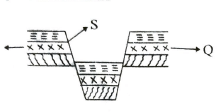
- The above diagram shows the formation of
- Block mountain
- Rift valley
- Corrie lakes
- Fold mountains
- Name the part marked S;
- ridges.
- ranges
- escarpment
- inselberg
- The following skills were taught to children in the past. Which one was taught through apprenticeship?
- Ironsmelting
- Collecting firewood
- Herding animals
- Fetching water
- Which country below is correctly matched with its capital city?
- Djibout - Asmara
- Uganda - Kampala
- Tanzania - Dar-es-Salaam
- South Sudan-Khartoum
- Who among the following pairs of leaders collaborated with the Europeans?
- Nabongo Mumia and Mekatilili
- Kabaka Mwanga and Koitalel Arap Samoci
- Kabaka Mutesa and Oloibon Lenana
- Mekatilili and chief Mkwawa
- In the Buganda kingdom, the Prime minister was known as;
- Omulamuzi
- Katikiro
- Bataka
- kabaka
Use the diagram below to answer questions 17 and 18
- The above diagram shows the formation of
- sea brecze
- land breeze
- orographic rainfall
- cyclonic rainfall
- The following Eastern African towns are likely to experience the above occurrence except;
- Jinja
- Mombasa
- Addis Ababa
- Kisumu
- Which one of the following cases represents a representative democracy?
- Few people are chosen to make decisions
- All individuals are involved in decision making
- All people vote on a popular issue
- No one is allowed to make decision on behalf of another
- Which one of the following countries does not neighbour Eastern Africa?
- South Africa
- DRC
- Libya
- Egypt
- The first president of Tanganyika was known as;
- Jomo Kenyatta
- Haile Selassie
- John Maghufuli
- Julius Nyerere
- The following are uses of diatomite. Which one is not. It is used to make;
- water filters
- toothpaste
- heat insulators
- hospital platers
- The main tourist attraction along the coast of Kenya and Tanzania is,
- Wildlife
- Sundy beaches
- Historical sites
- People's culture
- The following are bantu communities found in Uganda. Which one is not?
- Batoro
- Buganda
- Abagusii
- Banyankole
- Munga wants to vie for a scat as an MCA in his ward. Which one of the following is not one of the qualifications he should have?
- Be very rich
- Be 18 years and above
- Be a registered voter
- Be of sound mind
- Which one of the following cattle breeds is not likely to be found in Kongwa ranch?
- Aberdeen Angus
- Charolais
- Galloway
- Freshian
- When the river-lake Nilotes len South Sudan, they first settled at in Northern Uganda before moving to their present homelands?
- Shungwaya
- Kampala
- Pubungu Pakwach
- Bahrel-Gazal
- Which one of the following countries lie wholly to the South of the equator?
- Uganda
- Tanzania
- Djibouti
- Somalia
- European powers scrambled for colonies in Eastern Africa for all the following reasons except;
- to continue with slave trade
- to search for raw materials
- to get a market for their finished goods
- to get a place to settle their surplus capital
- Which one of the following is not a national philosophy?
- Harambee
- African socialism
- Nyayoism
- Punguza mizigo
- The following are members of the national assembly except;
- 47 elected woman representatives
- 12 members nominated by political parties
- 16 women nominated by political parties
- 1 speaker
- The road sign below means,

- bumps ahead
- road narrows
- no entry
- round about ahead
- Which one of the following rivers is not a tributary of R. Nile?
- R. Albara
- Blue Nile
- R. Omo
- R. Sabat
- The main problem facing inland fishing in L. Victoria is;
- poor transport network
- lack of refrigeration facilities
- growth of water weeds
- dispute over fishing grounds
- Which community below did not settle in Tanzania after migration from the Congo Basin?
- Wanyamwezi
- Pokomo
- Wasukuma
- Waluguru
- The weather instrument below is known as;
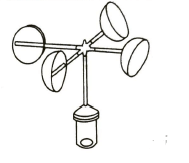
- barometer
- anemometer
- windvane
- windsock
- Which one of the following hoxes consists only of imports into Eastern Africa?
- Motor vehicles
Fertilizers
Medicines - Tea
Flowers
Coffee - Soda ash
Foot wear
Flowers - Gold
Copper
Tea
- Motor vehicles
- Which one of the following lakes below was formed through downwarping?
- L. Victoria
- L. Tana
- L. Kanyaboli
- L. Paradise
- The following wore functions of the clans in traditional African societies. Which one is not
- Settling disputes among the members
- Punishing the law breakers
- Assisted members during the time of bereavement
- Looked for marriage partners for their youth
Use the map below to answer the Questions that follow.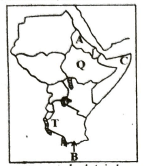
- The country marked A is known as;
- Sudan
- Eritrea
- Djibouti
- South Sudan
- People who followed route B during their migration are likely to be;
- Nyamwezi
- Wasukuma
- Luo
- Ngoni
- Which one of the following reasons best explains why country C remains dry most times of the year?
- Its Coastline is parallel to the winds
- It is close to the Indian Ocean
- It's big in size
- It is crossed by the Equator
- Lake T on the map is famous for the production of__fish.
- tilapia
- trout
- dagaa
- mullet
- Which one of the following statements is pot trde about the country marked Q?
- It was not colonized
- It is a major producer of coffee
- English is the National language
- Its head of state is a prime minister
- The following mountains were formed by faulting and uplifting except;
- Mt. Ruwenzori
- Pare mountains
- Mau ranges
- Mt. Ras Dashan
- Miombo Woodland in central Tanzania in spansely populated mainly because;
- It is reserved for wildlife
- it is extremely hot and dry
- it is tsetse fly infested
- poor roads and railway network
- The headquarters of the Inter-Governmental Authority on Development (IGAD) are found at;
- Djibouti
- Arusha
- Addis Ababa
- Nairobi
- In which year was Kenya declared a British protectorate?
- 1920
- 1895
- 1905
- 1885
- The cheapest method of preserving food is by:
- salting
- refrigeration
- canning
- sun drying
- During a general election, the person in charge of elections in a polling station is known as;
- presiding officer
- returning officer
- polling clerk
- IEBC chairman
- In the Nyamwezi chiefdom, the person who collected taxes from traders and trespassers was known as;
- Mkwale
- Minule
- Mteko
- Kikoma
- Which one of the following is not an importance of the constitution?
- Promotes political instability in Kenya
- Guarantees the rights and freedoms of citizens
- Enables Kenyans to live in harmony
- States how the people should be governed
- Which one of the following National parks is correctly matched with the country where it is located?
- Omo - Sudan
- Ruaha - Uganda
- Sibiloi - Ethiopia
- Serengeti - Tanzania
- The following are examples of marine fish except;
- tuna
- snappers
- dagaa
- sardines
- The following are positive effects of colonial rule in Kenya except:
- introduction of formal education
- introduction of African native reserves
- introduction of modern medicine
- improvement of infrastructure
- The following are facts about an African leader
- He maintained the independence of his count
- He abolished slavery in his country
- He participated in the formation of OAU
- He was the last emperor in his country
The leader discussed is;- Julius Nyerere
- Haile Selassie
- Kabaka Mutesa II
- Jomo Kenyatta
- Which box below consists only of the rivers that drains in the Indian ocean?
- Nile
Tana
Sabaki - Tana
Sabaki
Wami - Pangani
Nile
Juba - Nzoia
Tana
Kerio
- Nile
- In Kenya, it is the duty of the_ to maintain law and order.
- Judiciary
- Parliament
- National police service
- President
- Which one of the following countries is not a member of East African Community (EAC)?
- Ethiopia
- Rwanda
- Kenya
- Tanzania
- The early visitor to Eastern Africa who started cloves plantation and slave trade along the Coast is;
- John Speke
- Dr. David Livingstone
- Ludwig Krapf
- Seyyid Said
C.R.E
- What did God do after creating the world and everything in it?
- He rose again
- He cursed the creation
- He died
- He rested
- Esau wanted to kill his brother Jacob mainly because;
- Jacob had taken his blessings
- Jacob was loved by his mother
- Esau hated Jacob
- Esau wanted to take Jacob's wealth
- The angel of death did not kill the Israelite firstborn males because
- they defended themselves
- they were leaving Egypt that night
- they had obeyed God's command
- there was darkness over Egypt
- Noah built the ark mainly because;
- he wanted to save his family
- he was instructed to do so by God
- he was a wealthy man
- he wanted to become famous
- Who among the following kings of Israel was a shepherd?
- David
- Saul
- Solomon
- Jeroboam
- Which one of the following is the third book in the Old testament.
- Exodus
- Deutronomy
- Numbers
- Leviticus
- Who among the following was the forerunner of Jesus Christ?
- John the baptist
- Prophet Isaiah
- Simon Peter
- Angel Gabriel
- On the Pentecost day, the disciples spoke in tongues because;
- they were filled with the Holy Spirit
- they had come from different tribes
- they were instructed to do so
- they were God's chosen people
- Who among the following prophets announced the birth of Jesus in Bethlehem?
- Jeremiah
- Isaiah
- Hosca
- Micali
- Which one of the following activities in African Traditional Societies marked transition from childhood to adulthood?
- Initiation
- Naming
- Birth
- Marriage
- After the death of Moses, the Israelites mourned him for days.
- 40
- 120
- 20
- 30
- From the story of David and Jonathan we learn that we should:
- envy others
- practice nepotism
- betray others
- be faithful to one another
- Which one of the following is a gift of the Holy spirit?
- Love
- Peace
- Kindness
- Preaching and teaching
- During famine African Traditional Communities prayed to God as their;
- defender
- multiplier
- protector
- provider
- After initiation youths were expected to;
- worship God
- go for war
- start a clan
- marry or get married
- The father of Gideon was;
- Manoah
- Abimelech
- Tola
- Joash
- The parable of the prodigal son teaches about;
- second coming of Christ
- being ready always
- praying always
- repentance and forgiveness
- Which one of the following qualities of leadership was mainly shown by David when he killed Goliath?
- Courage
- Honesty
- Faithfulness
- Humility
- From the Apostle's creed, we learn that Jesus is;
- a saviour
- a judge
- our father
- our Lord
- The two disciples of Jesus whom He met after His resurrection were on their way to
- Emmaus
- Jerusalem
- Jericho
- Bethlehem
- At Joppa, apostle Peter,
- raised Tabitha to life
- healed a crippled beggar
- healed Aeneas
- raised Lazarus to life
- Which disciple was stoned to death because of his faith in Jesus?
- John
- Stephen
- Andrew
- Peter
- Which gift was brought to Jesus by the wisemen that shows priesthood?
- Gold
- Frankincense
- Silver
- Myrrh
- Which two people were filled with Holy spirit and chosen by God to design the covenant box?
- Peter and Andrew
- Paul and Silas
- Bezalel and Oholiab
- Philip and Stephen
- Which value is not required when breaking bread?
- Love
- Unity
- Humility
- Hatred
- The second Passover meal for the Israelites was celebrated in;
- Egypt
- Canaan
- Midian
- Wilderness
- Who among the following did not die?
- Moses
- Jesus
- Elijah
- Stephen
- What was the main virtue that was taught to the young people by the old people?
- Kindness
- Joy
- Obedience
- Wisdom
- Why do Christians respect the churches today?
- They are clean
- They are sacred places
- Many people go there
- It is the best place to be
- Christians should not condemn people living with HIV/AIDs in the society mainly because;
- it affects the whole society
- they should show love and compassion to them
- it is a painful disease
- anyone can get it
MARKING SCHEME

Science Questions and Answers - Class 7 End of Term 1 Exams 2022 Set 1
QUESTIONS
- Which one of the following type of soil erosion is characterised by small channels on sloping land?
- Sheet erosion
- Gulley erosion
- Rill erosion
- Splash erosion
- The method of food preservation that works by making bacteria inactive is;
- drying
- canning
- smoking
- freezing
- The brightest planet in the solar system is;
- Mars
- Mercury
- Earth
- Venus
Use the diagram below to answer questions 4 and 5.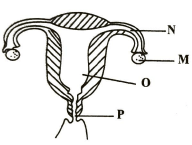
- Fertilization takes place in the part labelled;
- M
- N
- O
- P
- A mature ova is released from part M every 28 days through a process called;
- menstruation
- ovulation
- fertilization
- urination
- The most refracted colour of the rainbow is;
- violet
- red
- indigo
- orange
- The following are methods of controlling soil crosion. Which one is not?
- Contour ploughing
- Planting cover crops
- Digging along the slopes
- Mulching
- Which one of the following animal feeds is not classified as a concentrate?
- Dairy meal
- Silage
- Sow and weaner
- Growers mash
- For a seed to germinate, the gas needed
- Nitrogen
- Carbon dioxide
- Argon
- Oxygen
- The component of soil being investigated in the experiment below is;
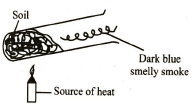
- water
- organic matter
- mineral particles
- air
- Which one of the following water-borne diseases can be controlled by draining stagnant water?
- Bilharzia
- Typhoid
- Cholera
- Malaria
- Which one of the following objects has a definite volume but no definite shape?
- A piece of chalk
- Carbon dioxide
- Kerosene
- Sand
- The experiment below was used to investigate a certain process in plants. The set-up was placed in the sunlight for a few days.
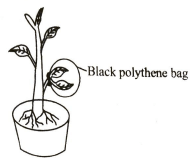
The process demonstrated above is;- absorption in plants
- photosynthesis in plants
- transportation in plants
- transpiration in plants
- In which of the following objects will sound travel the slowest?
- Metal
- Wood
- Water
- Air
- The following are signs and symptoms of a certain water-borne disease.
- Severe abdominal pains
- Violent diarrhoea with mucus
- Dehydration The disease can be prevented by;
- wearing protective clothing
- draining stagnant water near the home
- boiling drinking water
- killing fresh water snails
- Which one of the following mammals reproduces by laying eggs?
- Bat
- Duck-billed platypus
- Ostrich
- Monkey
- HIV/AIDS can be transmitted through the following ways except;
- sexual intercourse
- sharing skin piercing tools
- mosquito bites
- mother-to child during delivery
- The type of pollination shown in the diagram below is;

- insect pollination
- cross pollination
- self pollination
- wind pollination
- The type of food responsible for growth of new tissues and repair of worn-out body parts is;
- proteins
- carbohydrates
- vitamins
- mineral salts
- Which one of the following is a use of water in the industries?
- Cooling machines
- Cooking
- Mixing acaricides
- Boat riding
- On which principle does a raingauge work?
- Liquids occupies space
- Liquids expands when heated and contract when cooled
- Air in motion
- Air is a mixture of gases
- Std. 6 pupils did the experiment below.

All the following happens after some time except:- the candle goes off
- water enters the glass
- water rises in the
- the level of water in the basin drops
- What were the pupils likely to be investigating?
- Oxygen is used in burning
- Oxygen is needed during photosynthesis
- Air has mass
- Air expands
- The smoothness or coldness of soil is known as:
- drainage
- capillarity
- water retention
- soil texture
- Which one of the following crops is not a tuber?
- Cassava
- Greengrams
- Yams
- Sweet potatoes
- Which one of the following parts of the male reproductive system is wrongly matched with its function?
- Testis - Produce sperms
- Spermduct - Store sperms
- Scrotum - Regulate the temperature of the testis
- Urethra - allow the passage of sperms and urine outside the body
- Chrispine dropped a coin in water and it appeared raised as shown below.
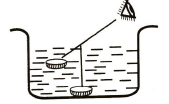
This is due to;- splitting of the white light
- refraction of light
- reflection of light
- dispersion of light
- The tendency of an object to remain in its state either moving or stationary is known as;
- motion
- gravity
- weight
- inertia
- Who among the following children ate a balanced diet?
- Faith - Termites, groundnuts, pork
- Mary - Beef, mutton, fish
- Fidelis - Ugali, green grams, kales
- Alice - Potatoes, matoke, cabbage
- The following are examples of rotational methods of grazing except:
- strip grazing
- paddocking
- tethering
- herding
- The air we breathe in is cleaned in the:
- air sac
- nose
- bronchus
- mouth
- Which one of the following boxes consists of body fluids through which HIV can be transmitted?
- Digestive juices
Blood
Semen - Semen
Saliva
Blood - Bile
Breast milk
Vaginal fluid - Mucus
Blood
Urine
- Digestive juices
- Which one of the following diseases is not included in the immunization schedule for infants?
- Tetanus
- Tuberculosis
- Malaria
- Measles
- Which one of the following materials will allow some light to pass through but you cannot see through them clearly?
- Frosted glass
- Mirror
- Clean water
- Wood
- The following are groups of cash crop except;
- beverage crops
- oil crops
- fibre crops
- tuber crops
- Which one of the following is not a use of water in the body?
- Prevents the skin from drying
- Prevents constipation
- Keeps the body tissues soft
- Prevents the skin from drving
- The diagram below shows a beam balance.

It is used to:- measure the weight of objects
- measure force of different objects
- compare mass of different objects
- measure the volume of objects
- The following are examples of legumes in livestock feeds except:
- nappier grass
- luceme
- clovers
- desmodium
- Which one of the following weeds is used as a vegetable?
- Sodom apple
- Oxalis
- Wandering jew
- Pigweed
- Which one of the following cannot cause death in animals?
- Starvation
- Being killed by other animals
- Boredom
- Old age
- Which one of the following is an effect of HIV/AIDS to the nation?
- Congestion in hospitals
- Low self-esteem
- Loss of family income
- Sadness in the family
- The following are signs and symptoms of a certain communicable disease.
- Rise in body temperature.
- Headache
- Pain in the joints
- Loss of appetite
The disease described above can be prevented through all the following ways except;- drain stagnant water
- covering all the surfaces of pools of water with oil
- immunization
- destroying empty containers
- When a force is applied on an object, the following can happen except;
- make a stationary object start moving
- change the state of an object
- reduce the speed of a moving object
- stop a moving object
- Which method of weed control also conserves moisture?
- Use of chemicals
- Slashing
- Digging out
- Mulching
- The following are characteristics of all animals except they;
- move from one place to another
- transpire
- remove waste
- reproduce
- The problem related to teeth shown in the diagram below is called;

- dental cavities
- bad breath
- bleeding gums
- plaque
- Which one of the following is not a characteristic of cumulus clouds?
- They are low in the sky
- They have a flat base
- They are white in colour
- They look like bundles of cotton wool
- On a see-saw, a small boy can lift a big boy when;
- they sit on the same side
- the two boys move equal distance from the pivot
- the big boy moves closer to the pivot
- the big boy sits further from the pivot
- The phase of the moon that cannot be seen at all is;
- full moon
- gibbous
- crescent
- new moon
- Which animal below does not have a moist skin?
- Crocodile
- Frog
- Salamanda
- Toad
MARKING SCHEME

Kiswahili Questions and Answers - Class 7 End of Term 1 Exams 2022 Set 1
MASWALI
Soma kifungu kifuatacho. Kina nafasi 1 hadi 15. Kwa kila nafasi lumepewa majibu manne. Chagua lifaalo zaidi.
Katika kijiji _1_ Gatiku _2_sehemu _3_ Monyo. Ni pahali _4_ na pa kuvutia kiasi _5_ mimi siwezi kuelezea _6_ maneno, labda uende ujionee kwa macho yako_7__ Mvuto wa Monyo hukamilishwa na _8_ ya kipekee yasiyo na _9_ , chemi chemi ya ajabu inayobubujikwa kwa lahani ya _10_ za kuliwaza. Wapo viboko na samaki _11_ wanaoogelea kwa madaha na ulimbwende madaha na ulimbwende _12_ wanyama wote majini. Kwa hakika chemi chemi ya Monyo, katika mbuga _13_ Manila _14__ pahali _15_ na maajabu ya mwenyezi Mungu Kijijini Gatiku.
-
- ya
- wa
- la
- cha
-
- ina
- lina
- wana
- kuna
-
- linaloitwa
- unaoitwa
- kunakoitwa
- inayoitwa
-
- mzuri
- nzuri
- pazuri
- mazuri
-
- ambamo
- ambalo
- ambacho
- ambayo
-
- na
- kwa
- ya
- kwenye
-
- yenyewe
- penyewe
- mwenyewe
- kwenyewe
-
- mandari
- mahali
- uzuri
- mandhari
-
- nishani
- sahani
- kifani
- shani
-
- wimbo
- nyimbo
- mashairi
- maneno
-
- maridadi
- wabora
- nyingi
- mengi
-
- kuwaliko
- kuiliko
- kuliko
- kumliko
-
- la
- wa
- ya
- mwa
-
- ndipo
- ndiyo
- ndilo
- ndiko
-
- penye
- pako
- palipo
- kuko
Kutoka swali la 16 hadi 30 jibu kulingana na maagizo.
- Kanusha sentensi ifuatayo:
Mwalimu wetu ni mkali.- Mwalimu watu ni mpole.
- Mwanafunzi wao ni mpole.
- Mwalimu wao si mrefu.
- Mwalimu wetu si mkali.
- Jibu la alamsiki ni:
- chewa
- binuru
- marahaba
- ya mafanikio
- Leo ni siku ya jumatano. Mtondogoo itakuwa siku gani?
- Jumapili
- Jumanne
- Jumamosi
- Ijumaa
- Chakula kilicholala huitwa?
- Makombo au masalia
- Mwikokipo
- Kiporo au mwiku
- Mabaki au staftahi
- Andika wingi wa sentensi ifuatavo:
Mtume anaheshimika.- Watume wanaheshimika.
- Matume yanaheshimika.
- Mitume yamcheshimika
- Mitume wanaheshimika
- Teua sentensi inayoonyesha "ki" ya masharti.
- Nilipomwona rais, alikuwa akikagua gwaride la heshima.
- Kijikaratasi hiki ndicho chenye maandishi.
- Alipowasili alitupata tukipiga domo.
- Tukitia bidii ya mchwa, tutafua dafu.
- Jaza pengo kwa kiashiria radidi kinachofaa
Nyangumi ....................... ndiye amenaswa na mtego ule.- huyu huyu
- huyu huyo
- lo hiyo
- yuyu huyu
- Shairi lenye mishororo mitatu katika kila ubeti huitwa:
- tarbia
- tathlitha
- takhmisa
- tathnia
- Ipi si zana ya kivita?
- Nyambizi
- Manowari
- Parafujo
- Kombora
- Akifisha sentensi ifutayo vyema.
Mama wee dadangu alishtuka- “Mama wee!" Dadangu alisema.
- "Mama wee?" dadangu alitamka.
- “Mama wee" dadangu alikiri.
- Mama wee! "Dadangu alisema."
- Unda kitenzi kutokana na neno mpishi.
- upishi
- pika
- upikaji
- upiki
- Tumia neno la heshima kujaza pengo.
......................... niazime kitabu chako nitakurudishia nikimaliza kufanya zoezi.- Tafadhali
- Samahani
- Pole
- Aisee
- Mchezo huu ..................... vizuri sana asubuhi.
- unachezesha
- unachezana
- unachezeshana
- unachezeka
- Neno "pua" hupatikana katika ngeli gani?
- LI-YA
- U-ZI
- I-ZI
- I-I
- Chagua neno lililo sawa na lililopigwa kistari.
Mfanyikazi aliyepigwa kalamu alikuwa mlegevu.- mjuzi
- mwenye bidii
- mwerevu
- mzembe
Soma habari ifuatayo kisha ujibu maswali 31 hadi 40.
Kuna maradhi yanayowatinga adinasi katika dunia hii. Mojawapo ya mawele hayo ni ugonjwa wa kifua kikuu. Ugonjwa wa kifua kikuu huathiri mapafu na inakadiriwa huua mamilioni ya watu kila mwaka duniani. Maradhi haya husababishwa na bakteria. Bakteria hawa huathiri kila sehemu ya mwili hasa mapafu. Aidha kifua kikuu huenezwa kwa haraka aliyeambukizwa anapokohoa au kuchemua na kutoa vijitone vya bakteria hao ambao huingia hewani na wengine huvuta.
Hata hivyo, watu wengi hawajui kwa sababu bakteria huvamiwa na kuingia mwilini. Kati ya mtu mmoja kwa watu ishirini inakadiriwa kuwa bakteria wengine huvamiwa na kuambukiza miezi au miaka kadhaa baadaye.
Dalili za maambukizi huanza kwa kikohozi chenye mwasho, ambacho huendelea kwa muda mrefu. Kikiendelea kuwa kikao kwa muda huo, mwele huwa na kikohozi ambacho huenda kikawa na matone ya ngeu. Dalili nyingine ni homa kali, kutokwa na jasho, kupoeza uzito, uchungu kifuani na kupoteza hamu ya chakula.
Ugonjwa huu usipotibiwa haraka huleta tatizo la kupumua, hatimaye huenea katika sehemu nyingine mwilini. Takribani nusu ya wote wanavkosa kutibiwa hufa. Inakisiwa kuwa katika mataifa maskini, watu milioni tatu hufa kila mwaka. Aidha maradhi hayo huandamana na Ukimwi ambao unadhoofisha mwili. Watu hupewa chanjo wakiwa wachanga ili kukinga uwele huu. Kwenye hospitali waganga hutumia njia kadhaa kuchunguza maambukizi ya kifua kikuu. Mgonjwa anapopewa dawa ni vizuri amalize kipindi chote cha dawa hata kama amepona huenda akasababisha kuibuka kwa ugonjwa wa kifua kikuu sugu.
- Kulingana na kifungu hiki ni ukweli kusema ugonjwa wa kifua kikuu huadhiri:
- mapafu pekee
- mbavu na mapafu
- kila sehemu ya mwili
- miguu na mapafu
- Mwele wa kifua kikuu huambukiza watu wengine ugonjwa huu haraka kupitia;
- Kukohoa na kuendesha
- Kukohoa na kuchemua
- Kuchemua na bakteria
- Bacteria na joto mwilini
- Ni asilimia gani ya watu wanaokadiriwa bacteria huweza kujificha na kuambukiza miezi na miaka kadhaa baadaye.
- Asilimia ishirini
- Asilimia moja
- Asilimia kumi
- Asilimia tano
- Mwandishi ametaja dalili ngapi za kifua kikuu?
- Mbili
- Sita
- Tano
- Saba
- Kifua kikuu husababishwa na:
- ukosefu wa kinga mwilini
- viini viitwavyo bakteria
- ukosefu wa usafi
- mtu kukohoa karibu na mwingine
- Ipi si njia ya kukinga kutokana na ugonjwa wa kifua kikuu?
- Alkupewa chanjo ukiwa na umri mdogo
- kujikinga kutokana na baridi
- kuepuka makao ya wagonjwa wenye ugonjwa huu.
- kuwatibu wagonjwa wa ugonjwa huu
- Mgonjwa anapopewa dawa ni vizuri:
- atumie dawa hizo kulingana na uwezo wake.
- anywe dawa hizo zote mara moja
- awache kutumia dawa hizo mara tu anapopona
- atumie dawa hizo hadi kipindi chote kikamilike hata kama amepata nafuu.
- Kati ya watu hawa, ni yupi asiyepatikana hospitalini?
- Mganga
- Daktari
- Mkutubi
- Muuguzi
- Ni nini maana ya kifua kikuu sugu?
- Ugonjwa wa kifua kikuu unaotibiwa haraka.
- Ugonjwa wa kifua kikuu unaotokana na ukimwi.
- Ugonjwa wa kifua kikuu usioweza kutibiwa kwa urahisi.
- Ugonjwa wa kifua kikuu usiokuwa na by dalili
- Kichwa gani kinachofaa kifungu hiki:
- Kifua kikuu sugu
- Maradhi bandia ya ukimwi.
- Ugonjwa wa kifua kikuu
- Dalili za kifua kikuu.
Soma habari inayofuata kisha ujibu maswali 41 hadi 50,
"Majambazi waliowateka nyara na kuwaua waja watatu katika tariki ya kutoka Kikochi kuelekea Kinango wangali wanasakwa na polisi. Taarifa ya hivi karibuni inatuarifu kuwa kuna baadhi ya mambo ambayo hayajabainika.
Yaaminika kuwa gari la aina ya V8 lenye rangi ya samawati lilikuwa na banati mmoja na maghulamu wawili. Vijana hawa walikuwa wa rika moja. Polisi wanasema kwamba mahuluki hao walistarehe katika hoteli moja va kifahari miini Kikochi kwa muda mrefu kabla ya kutoka hapo na kuelekea Kinange. Wakiwa njiani, watu hao walitekwa nyara na majambazi wasiojulikana na kuelekezwa hadi pahali pasipojulikana
Siku mbili baadave, mwili wa mwanamme mmoja aliyetambuliwa kama Juma ulipatikana ukiwa umetupwa kichakani kilichopewa jina la Wahaka huku amevujwa vunjwa mbavu. kichwa limevunjwa na meno yalikuwa yameng'olewa pamoja na macho.
Mwah mwingine wa mwanaume alivetambulika kama Kalembe, ulipatikana mtoni Mjengo ukiwa umekwama kwenye gogo la mti Askari wanaamini kwamba banati yule mmoja ann
mmoja aliyekuwa ganini mie pia aliuawa la sivyo majambazi hao wanamficha. Walakini cha mno ni kwamba kufikia sasa hakuna familia yoyote inayodai kumpoteza mwanamwali. Polisi wanauliza mja yeyote aliye na habari yoyote ile iwezayo kufumbua fumbo hilo asisite kuielezea kwenye kituo chochote cha usalama
- Majambazi waliowateka watu nyara:
- wako kizuizini
- hawajulikani walipo
- wametiwa mbaroni
- wamekamatwa
- Gari walilosafiria waliotekwa nyara lilikuwa la rangi ya:
- kijani
- manjano
- nyeusi
- buluu
- Mojawapo ya mambo ambayo bado hayajabainika ni:
- gari waliosafiria waliotekwa nyara
- miili yote ya waliotekwa nyara ilipo
- alipo mmoja wa watekwa nyara
- waliokuwa wametoka kabla ya kutekwa nyara
- Ni kweli kusema:
- watu hawa walitekwa nyara kabla ya kujivinjari huko kikochi
- miili ya watekwa nyara wote ilipatikana wakiwa wafu
- yakini majambazi wanamficha mwanamke aliyetekwa nyara
- uchunguzi wa polisi kuhusu uhalifu huu umefana
- Watu waliotekwa nyara huitwa:
- Mahabusu
- Majangili
- Mateka
- Majambazi
- Kulingana na taarifa hii, polisi wanashuku:
- mwanamke mmoja haeleweki vyema kuhusu mauti au uhai wake.
- waliouawa pia walikuwa majambazi
- mwanamke yule alishiriki mauaji ya waliokufa.
- waliotekwa nyara walijisalimisha kwa hiari.
- Miili ya waliouawa ilikuwa:
- imeoza
- imehifadhiwa
- kando
- pamoja
- Neno wahaka lina maana ya:
- wasiwasi
- giza
- vichaka
- hakika
- Jambo ambalo ni gumu kuelewa kama vifo hivi huitwa:
- kizunguzungu
- kikweukweu
- kitefutefu
- kizungumkuti
- Mada mwafaka ya habari hii ni:
- Sitofahamu ya mauaji
- Msitu wa wahaka
- Polisi wazembe
- Taaluma ya utekaji nyara
MARKING SCHEME


